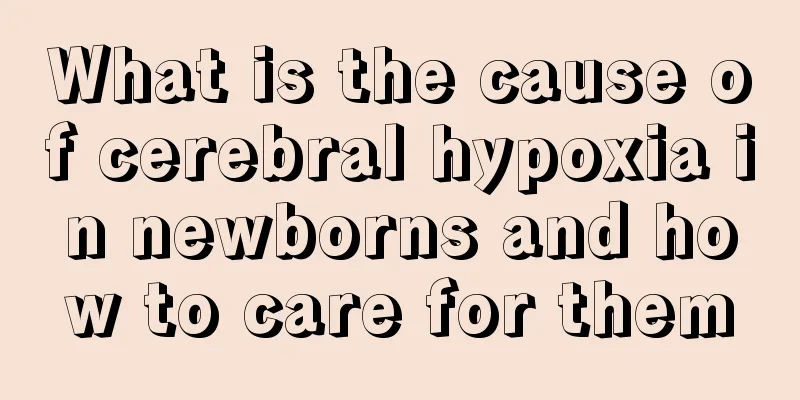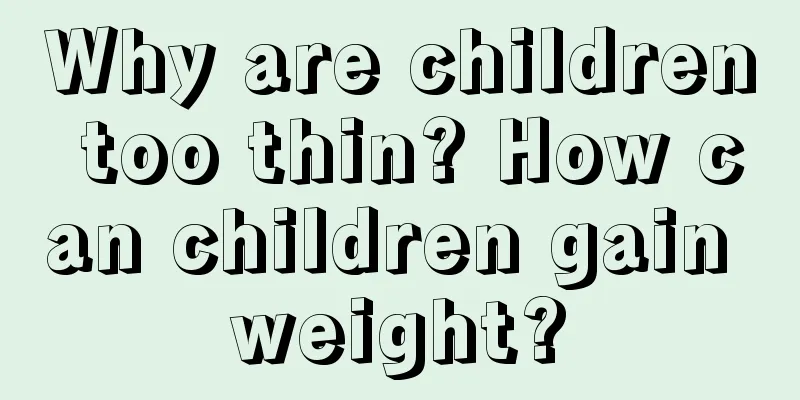What is the cause of cerebral hypoxia in newborns and how to care for them

|
Newborns may have more or less problems due to their inability to adapt to the external environment. Mothers are very worried about this, fearing that something unexpected will happen to their babies. Neonatal cerebral hypoxia is also a common symptom. Let's take a look at what precautions should be taken. What is the cause of cerebral hypoxia in newborns?1. Poor blood circulation in the umbilical cord: Umbilical cord knotting, umbilical cord around the neck, etc. may cause ischemic cerebral palsy in the newborn. 2. Newborn’s own diseases: Many diseases may cause hypoxia problems, such as congenital heart disease, increased red blood cell count, etc. 3. Placental causes: placental prolapse, previa or placental dysfunction can lead to ischemic cerebral palsy. 4. Jaundice: It is the main cause of cerebral palsy in newborns, but with the continuous development of modern medicine, the probability of causing cerebral palsy is also decreasing. 5. Problems during delivery: delayed delivery, malposition of the fetus, doctor-assisted use of forceps, anesthesia or prolonged delivery can also cause ischemic cerebral palsy. 6. Maternal causes: Ischemic cerebral palsy caused by pregnancy-induced hypertension syndrome, heavy bleeding, severe anemia, coma, drug poisoning, excessive smoking and drinking, etc. How to care for newborns with cerebral hypoxia1. Feeding and care: Breastfeeding is recommended. Mixed feeding is allowed when breast milk is insufficient. Feeding should be done in small amounts and multiple times. It is not recommended to feed too much, which may cause vomiting, choking, aspiration, aspiration pneumonia, and suffocation. When the baby is 4 to 6 months old, complementary food should be added in time. Foods that are easily digestible and nutritionally balanced should be selected. Vitamin AD (select OTC label) should be supplemented 15 days after birth until the baby is 2 years old. In summer, there are many outdoor activities, so it can be suspended for about 2 months. 2. Temperature care: The temperature should be balanced. In summer, the indoor temperature should be kept at 25-28 degrees. The difference between indoor and outdoor temperature should not exceed 6 degrees. Ventilate frequently to ensure fresh indoor air. 3. Environmental care requirements: When caring for children with cerebral hypoplasia, the ward should be kept quiet and clean. Do not move the baby easily, and avoid noisy surroundings. Clean the indoor floor and disinfect it frequently. Patrols should be strengthened day and night to prevent accidents such as the baby falling out of bed, hurting himself or others, etc. 4. Psychological care: If the treatment time for babies with severe cerebral hypoxia is too long, parents may become impatient and even want to give up treatment. Therefore, adjusting your mentality will play a vital role in the baby's treatment. Symptoms of cerebral hypoxia in newborns1. Mild cerebral hypoxia. If it is a relatively mild cerebral hypoxia problem, the child will be over-awakened, and the child will be more irritable, excited, and more likely to have shaking and tremors. However, at this time, the child's muscle tone will not be abnormal, the hug reflex is also normal, and the breathing is relatively stable. This situation will gradually disappear within three days. 2. Moderate cerebral hypoxia. In this case, the child is in a state of inhibition, and the child's muscle tension is relatively low. At this time, the child prefers to sleep or is in a state of shallow coma. Half of the cases have convulsions or respiratory arrest. The child's hugging or sucking reflex will also be weakened. If this situation persists for a week or ten days, it must be treated. 3. Severe cerebral hypoxia. The child will be in a coma, and the child's muscle tone will be particularly low. The child will be relatively soft, both the hugging reflex and the tendon reflex will disappear, and the pupils will be unequal. Some may even have respiratory failure and other abnormal conditions. The mortality rate is relatively high in severe cases, and even if they survive, there will be sequelae. Can newborns heal themselves?Neonatal cerebral hypoxia can be cured. If the degree of cerebral ischemia and hypoxia is mild and discovered early, the child can be cured. If there is no bleeding, then the problem is not big. When the baby is three months old, observe the baby's mental state and sense of sound and grasping. If it is normal, then there is basically no problem. If there is a slight change, rehabilitation exercises can be performed. |
Recommend
Are Vinda wet wipes safe? Can Vinda wet wipes be used to wipe the face?
Nowadays, wet wipes are basically prepared at hom...
How long after the baby is infused can he take a bath? What are the hazards of frequent infusion for babies?
After a baby has been sick and received an IV dri...
What should I do if my baby is breathing rapidly?
Does your baby sometimes breathe fast and grunt? ...
Is there any relationship between baby spitting up and milk powder? Does the baby need to change the milk powder if he spits up?
Is there a relationship between baby spitting up ...
How to clean milk stains in baby bottles? What are the hazards of milk stains in baby bottles?
If the kettle used to boil water at home is used ...
How long does it take to charge an Oral-B electric toothbrush? Does the Oral-B electric toothbrush need to be placed on the base all the time?
The Oral-B electric toothbrush feels really good ...
What are the benefits of cesarean section? 4 major benefits to pay attention to
Caesarean section and natural birth each have the...
What should I pay attention to when bathing a baby girl? Special requirements for bathing a baby girl
What should I pay attention to when bathing a bab...
Why do children have to learn dancing?
It is very important to let children keep the hab...
Is nebulization useful for children with bronchitis? How many days should nebulization be used for children with bronchitis?
For pediatric bronchitis, nebulization treatment ...
What should newborns wear in winter? How should newborns dress in winter?
In winter, many parents think that the weather is...
Can I wean my baby on the beginning of autumn? Is it good to wean my baby on the beginning of autumn?
Can I wean my baby during the Beginning of Autumn...
What are the causes of childhood obesity and how to lose weight effectively
Many children today are overweight due to disorde...
How much is a bottle of baby flaxseed oil? How many months does a baby eat flaxseed oil?
Flaxseed oil is a very common edible oil in our l...
What are the symptoms of zinc deficiency in children and what causes it
Many children suffer from zinc deficiency because...









